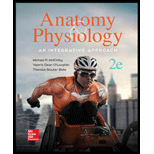
Anatomy & Physiology: An Integrative Approach
2nd Edition
ISBN: 9780078024283
Author: Michael McKinley Dr., Valerie O'Loughlin, Theresa Bidle
Publisher: McGraw-Hill Education
expand_more
expand_more
format_list_bulleted
Question
Chapter 26.1, Problem 4WDYL
Summary Introduction
To determine:
The purpose served by muscular sphincters along the length of GI tract.
Concept introduction:
The hollow tube from the esophagus to large intestine is known as alimentary canal or GI tract. GI tract is made up of four-layer or tunics. Innermost mucosa, submucosa, muscularis and outermost layer adventitia or serosa is the four concentric layer of GI tract wall.
Expert Solution & Answer
Want to see the full answer?
Check out a sample textbook solution
Students have asked these similar questions
What purpose is served by muscular sphincters at various locations along the length of the GI tract?
What is the function of muscularis mucosa?
Match the following layer to their functions:
1. submucosa 2. serosa 3. lamina propria 4. muscularis mucosa 5. muscularis and subserosa
a) it has similar function with visceral peritoneum b) peristalsis c) gastric juice production d) expels g.j. e) it connects muscle to epithelium layer
Chapter 26 Solutions
Anatomy & Physiology: An Integrative Approach
Ch. 26.1 - What is the primary difference between mechanical...Ch. 26.1 - Prob. 2WDYLCh. 26.1 - What specific layer(s) must substances cross to...Ch. 26.1 - Prob. 4WDYLCh. 26.1 - Prob. 5WDYLCh. 26.1 - What is the difference between intraperitoneal and...Ch. 26.1 - Where is the greater omentum located?Ch. 26.1 - Prob. 8WDYLCh. 26.1 - Prob. 9WDYLCh. 26.2 - Prob. 10WDYL
Ch. 26.2 - Prob. 11WDYLCh. 26.2 - Prob. 12WDYLCh. 26.2 - How is the bolus moved from the oral cavity into...Ch. 26.2 - Prob. 14WDYLCh. 26.2 - Prob. 15WDYLCh. 26.3 - What organs are considered part of the lower GI...Ch. 26.3 - What are the three anatomic structures that...Ch. 26.3 - Prob. 18WDYLCh. 26.3 - Where do deoxygenated, nutrient-rich blood and...Ch. 26.3 - Prob. 20WDYLCh. 26.3 - Prob. 21WDYLCh. 26.3 - Prob. 22WDYLCh. 26.3 - Prob. 23WDYLCh. 26.3 - Which substances are typically absorbed by the...Ch. 26.4 - What enzymes are required to completely break down...Ch. 26.4 - How are proteolytic enzymes activated in the...Ch. 26.4 - What is the function of bile salts in lipid...Ch. 26.4 - Prob. 28WDYLCh. 26 - _____ 1. Which organ is located in the right upper...Ch. 26 - _____ 2. The _____ cells of the stomach are...Ch. 26 - _____ 3. Which of the following is an unregulated...Ch. 26 - _____ 4. Which organ (or part of an organ) is...Ch. 26 - _____ 5. Pancreatic juice contains a. HCO3 and...Ch. 26 - _____ 6. Bile is transported through the a....Ch. 26 - _____ 7. Digestion of proteins begins in the a....Ch. 26 - Prob. 8DYKBCh. 26 - _____ 9. Digestive enzymes that chemically digest...Ch. 26 - _____ 10. Most of the absorption of our digested...Ch. 26 - The GI tract from the esophagus to the anal canal...Ch. 26 - Discuss the reason why the involuntary sequence of...Ch. 26 - Prob. 13DYKBCh. 26 - Compare the structure of the circular folds,...Ch. 26 - Discuss why the tunica mucosa in the colon has a...Ch. 26 - Prob. 16DYKBCh. 26 - What is the role of the gallbladder in digestion?Ch. 26 - Describe the different forms of mechanical...Ch. 26 - Prob. 19DYKBCh. 26 - How are lipids absorbed in the GI tract?Ch. 26 - Prob. 1CALCh. 26 - Prob. 2CALCh. 26 - What component of the digestive tract can you not...Ch. 26 - The pancreatic ducts are blocked with a thick,...Ch. 26 - Prob. 5CALCh. 26 - Alexandra experienced vomiting and diarrhea and...Ch. 26 - A key event in the chemical digestion processes...Ch. 26 - Most cases of colorectal cancer occur in the most...
Knowledge Booster
Similar questions
- Where along the GI tract is the muscularis composed of skeletal muscle? Is control of this skeletal muscle voluntary or involuntary?arrow_forwardIdentify this component/region of the wall of the digestive tract Choose one from the following: (A) muscularis mucosa (B) submucosa (C) muscularis externa - innermost circular layer (D) muscularis externa - innermost oblique (E) muscularis externa - inner circular (F) muscularis externa - inner longitudinal (G) muscularis externa - inner obilquearrow_forwardin studying digestion (specifically the duodenum and pancreas) What is the difference between the sphincter of odii, ampula of vater, duodenal papilla and hepatopancreatic sphincter?arrow_forward
- When sensors in the GI tract are stimulated, they respond via reflexes. What types of digestive activity may be put into motion via those reflexes?arrow_forwardWhich structures of the lamina propria of the small intestine are responsible for transporting absorbed lipids (fats)? O Blood capillaries O Lacteals O Peyer's patches O MALT tissue O Duodenal glands Question 24 What structure of the large intestine is made up of the longitudinal strips of smooth muscle? O Internal anal sphincter O Pyloric sphincter O Teniae coli O Epiploic appendage O Cardiac sphincterarrow_forwardIn what ways will digestion be compromised when afflicted with a medical condition along the GI tract?arrow_forward
- Explain Segmentation contractions in a portion of the small intestine?arrow_forwardThe motion of these muscles causes waves of contraction to move down the length of the small intestine. What purpose do these waves of contraction serve?arrow_forwardWhat modification of the stomach muscularis externa allows it to mechanically digest food?arrow_forward
- What are the two main types of muscle movements in the Digestive tract? How are they different? What is an example of where each function?arrow_forwardwhy is there a need for sphincters in the stomach? what will happen otherwise?arrow_forwardDetermine the initial site of digestion (chemically) of the following:(1) Carbohydrates(2) Lipids(3) Proteinsarrow_forward
arrow_back_ios
SEE MORE QUESTIONS
arrow_forward_ios
Recommended textbooks for you
 Human Physiology: From Cells to Systems (MindTap ...BiologyISBN:9781285866932Author:Lauralee SherwoodPublisher:Cengage Learning
Human Physiology: From Cells to Systems (MindTap ...BiologyISBN:9781285866932Author:Lauralee SherwoodPublisher:Cengage Learning

Human Physiology: From Cells to Systems (MindTap ...
Biology
ISBN:9781285866932
Author:Lauralee Sherwood
Publisher:Cengage Learning